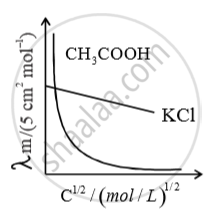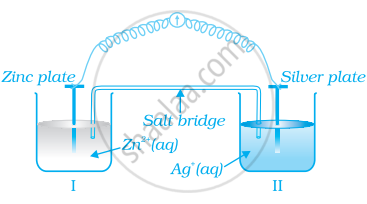Advertisements
Advertisements
Question
How can you determine limiting molar conductivity, 0 m for strong electrolyte and weak electrolyte?
Solution

For strong electrolyte, plot of m
against c, extrapolated to the y-axis, gives the value of m for
strong electrolyte. For weak electrolyte, intercept is not obtained as o m
cannot be extra apolated to zero conc. hence limiting molar conductivity of weak electrolyte is obtained from that of strong electrolytes. Using Kohlrausch law of independent migration of ions.
`λ_m^0(CH_3COOH) = lamda^0CH_3COONa + lamda_{HCl}^circ - lamda_{NaCl}^circ`
`lamda_m^circ(CH_3COOH) = lamda_{CH_3COO-}^circ + lamda_{H^+}^circ`
APPEARS IN
RELATED QUESTIONS
The conductivity of 0.20 mol L−1 solution of KCl is 2.48 × 10−2 S cm−1. Calculate its molar conductivity and degree of dissociation (α). Given λ0 (K+) = 73.5 S cm2 mol−1 and λ0 (C1−) = 76.5 S cm2 mol−1.
The conductivity of 0.02M AgNO3 at 25°C is 2.428 x 10-3 Ω-1 cm-1. What is its molar
conductivity?
Calculate the degree of dissociation (α) of acetic acid if its molar conductivity (Λm) is 39.05 S cm2 mol−1.
Given λ°(H+) = 349.6 S cm2 mol−1 and λ°(CH3COO−) = 40.9 S cm2 mol−1
Conductivity always decreases with decrease in concentration both, for weak and strong electrolytes because of the fact that ____________.
Molar conductivity of ionic solution depends on:
(i) temperature.
(ii) distance between electrodes.
(iii) concentration of electrolytes in solution.
(iv) surface area of electrodes.
Write the cell reaction of a lead storage battery when it is discharged. How does the density of the electrolyte change when the battery is discharged?
Consider figure and answer the question to given below.
How will the concentration of Zn2+ ions and Ag+ ions be affected after the cell becomes ‘dead’?
An increase in equivalent conductance of a strong electrolyte with dilution is mainly due to :-
The molar conductance of \[\ce{NaCl, HCl}\] and \[\ce{CH3COONa}\] at infinite dilution are 126.45, 426.16 and 91.0 S cm2 mol−1 respectively. The molar conductance of \[\ce{CH3COOH}\] at infinite dilution is. Choose the right option for your answer.
Assertion (A): Molar conductivity decreases with increase in concentration.
Reason (R): When concentration approaches zero, the molar conductivity is known as limiting molar conductivity.
